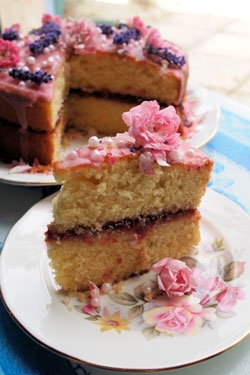
Karen S Burns-Booth is the author of popular foodie blog Lavender and Lovage. Her love of seasonal food and recipes stems from her early childhood which was spent observing her and mother and grandmother’s cookery skills, both in rural Northumberland and whilst living overseas in South Africa and Hong Kong. Widely travelled, Karen embraces all different manners of foods, cookery techniques, cultures and traditions. In this guest post she talks about the age-old practice of using flowers in cooking…
Using flowers in the kitchen has been around since the ancient Greeks, they have also been used in Chinese, Middle Eastern, and Indian cuisines, and as well as being used in symbolism, as in the “language of flowers” and their meanings; flowers have been incorporated in baking, cooking and medicinal potions for centuries in Great Britain.
The Medieval still room was a place where the mistress of the house would “brew” and mix her syrups, cordials, ales, medicines and many other herbal and floral concoctions, and she would be in tune with the passing seasons and nature, harvesting what was needed throughout the year, in order to make medicines and festive drinks, as well as the age-old custom of strewing pungent herbs and flowers on the floor of her family home, as it was thought to protect the gentlefolk from germs and provide fragrances to mask the smells – a sort of early aromatherapy if you will.
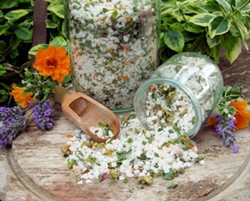
Moving away from the art of “Floriography” (which is the art of sending messages by flowers with meanings attached the colour and type of flower that you gave or sent), flowers also made their way into most people’s kitchens; marigolds and rose petals were scattered over blancmanges, as well as using rose water in numerous recipes too. Lavender was candied, as well as other edible flowers such as violets, rose petals and primroses, and cordials and champagne was made with elderflowers and dandelions. Vibrant syrups were made with violets and my sweet violet syrup is still the most requested recipe as asked for by my family and friends! Flowers were used in salads, and the Elizabethans especially loved their herb and floral salads, which were served in between course of grand banquets as a “stomach purgative”
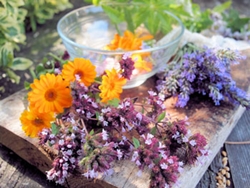
As we approach the end of summer, now is an ideal time to use or gather your flowers in for the fragrant kitchen; fresh flowers and herbs can be added to salt and sugar, where they are preserved in all their glory, retaining their colour and fragrance for using through the drear winter months. Rose cakes can be made in February with rose water, rose sugar and crystallised rose petals and stews, salads and soups can be dressed with a small spoon of floral salt. Another way I preserve my edible flowers is to freeze them in ice cubes, for a VERY special flourish to a festive cocktail, or even for a special dessert. Flowers also lend themselves to being preserved in oils and vinegars, as well as being dried and crushed for a colourful garnish to salads and puddings.
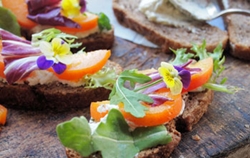
If you are unsure what flowers are edible, there are numerous books on the market at present, as well as many seed companies, who sell edible flower seeds to sow all year around. My personal favourites are: marigolds, roses, violets, honeysuckle, borage, violas, primroses, lavender, nasturtium, courgette flowers, chive flowers, marjoram flowers, thyme flowers, lilac and jasmine. It’s best to pick flowers just before you want to use them and when they are just opened, then wash carefully in cold water, mainly to get rid of any insects; once washed, gently pat them dry on kitchen paper or allow them dry naturally on a tray, spread out. They can then be stored in the refrigerator in a plastic bag until ready to use but preferably not longer than 3 days, and of course, you can preserve them as I mentioned before.
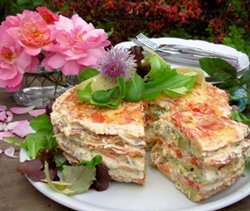
I hope I have inspired you to think of flowers OUTSIDE the vase, and on the plate! It’s nothing new really, as I said before, flowers have been used in cooking for thousands of years. There are many examples mentioned in early European literature; accounts of grand and magnificent medieval feasts are mentioned where beef and venison was cooked with marigolds, whilst salads were made with violets and honeysuckle blossoms. So, the next time you take a bouquet of flowers to give to a friend, family member or dinner hostess, why not do as I do, and add some EDIBLE flowers, with some edible flower recipes attached; they don’t have to be big or grandiose, a small bunch of flowers arranged in the manner of an edible posy would be received with delight and interest; release your floral spirit and eat some flowers, as well as admiring them in a vase, they will add a certain panache to the culinary proceedings!
Source: Interflora – Cooking with Flowers: A Posy of Flowers in the Kitchen





